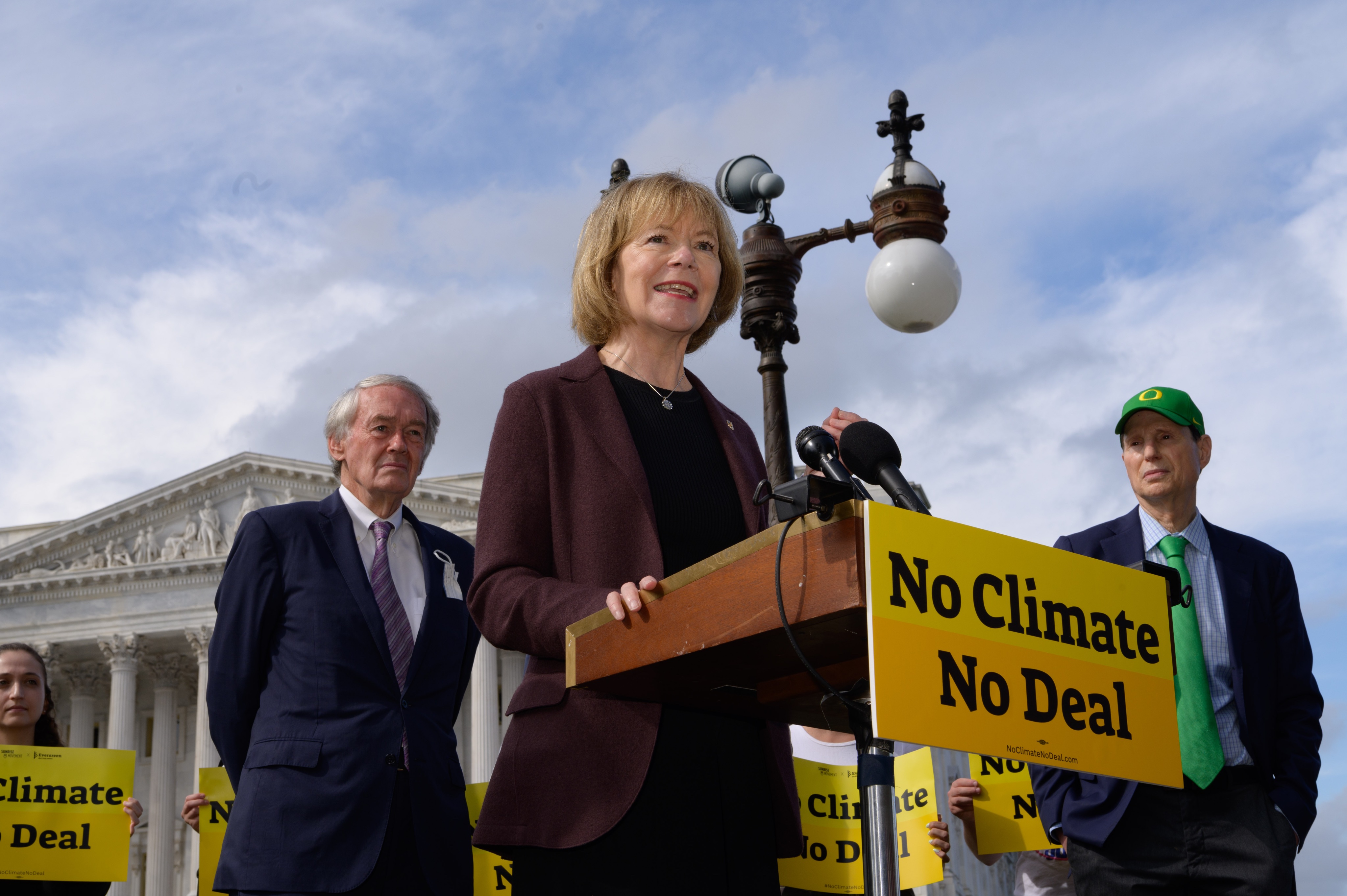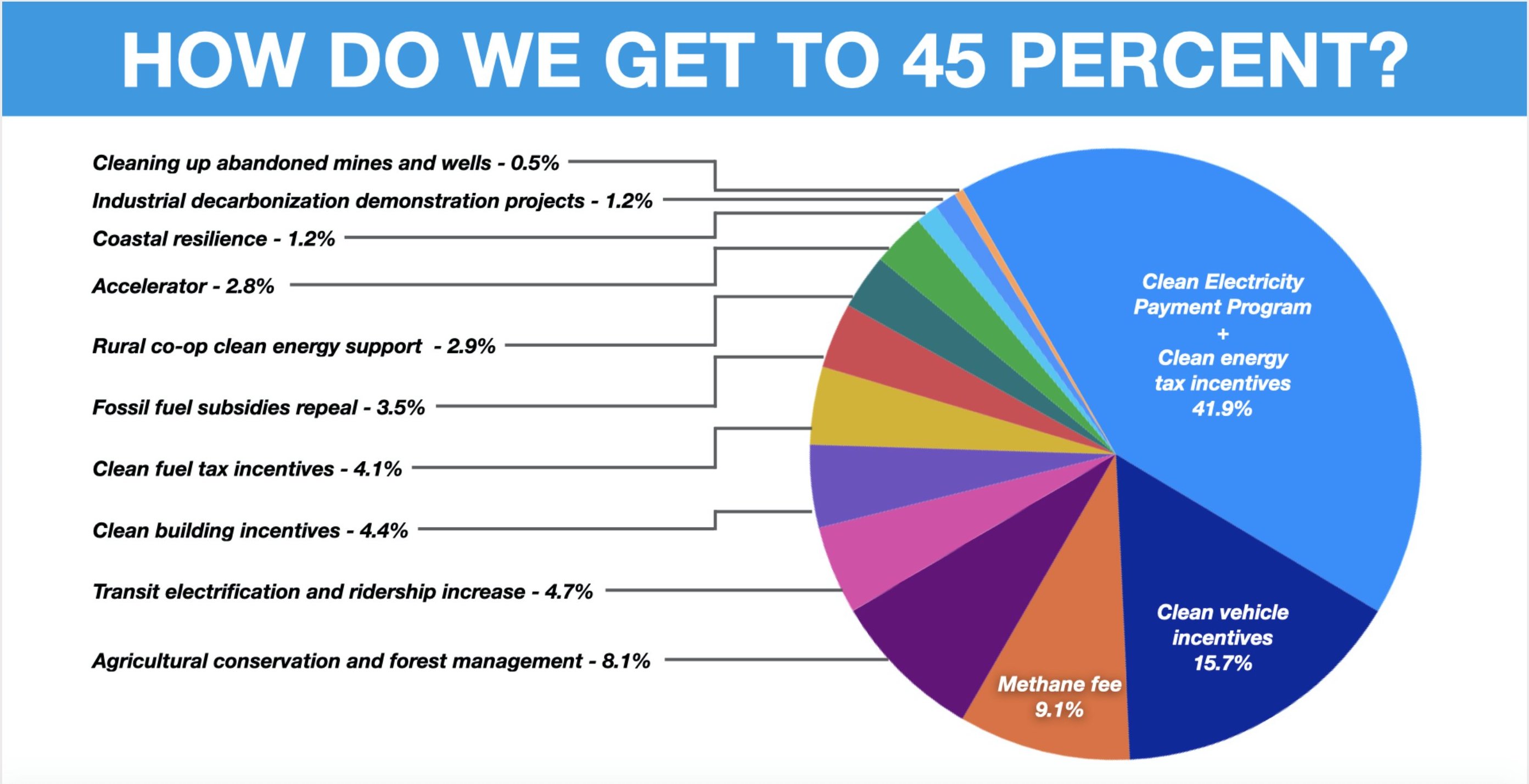Without the investments in the BBBA, President Biden will not be able to fulfill his commitments to the American people and the international community to fight the climate crisis. And if he goes to Glasgow next month empty-handed, President Biden won’t be able to restore America’s credibility as a global leader on climate change.
We can’t afford to squander this historic opportunity to create millions of good-paying jobs in an equitable and thriving clean energy economy and reestablish America’s standing as a global leader for climate action.
The Pollution-Reducing Investments Needed in the BBBA
The Build Back Better Act, as advanced through various House committees this summer, contains a number of crucial pollution reduction investments that must be maintained in the final package, including the Clean Electricity Performance Program, clean energy tax credits, building electrification incentives, the Greenhouse Gas Reduction Fund, and a methane polluter fee, as described below. Each of these critical policies is called for in the Evergreen Action Plan.
These investments, alongside investments in environmental justice communities, agricultural and conservation programs, transit buildout, and the repeal of fossil fuel subsidies—and more—will be essential to ensuring we meet the science- and justice-based pollution reduction goals that President Biden has set for the nation.
These investments must be implemented in line with President Biden’s Justice40 commitment to direct 40% of the benefits of federal climate and clean energy investments to disadvantaged communities. And they must be complemented with other climate and environmental justice and workforce investments to ensure a smooth and equitable transition to a clean energy economy. Robust action is needed now.
1. CEPP: President Biden’s Most Powerful Pollution-Reducing Program
Cleaning up the power sector, especially, through a Clean Electricity Performance Program (CEPP) is the most impactful climate investment under consideration in Congress. CEPP is an incentive-based program designed to transition America's power grid toward more carbon-free energy over the course of the decade. Under CEPP, utilities that add more than 4 percentage points of clean power per year are eligible for federal grants—a rate of clean energy growth that is critical to maintain in the final bill. Utilities that do not add adequate clean power must make payments to the federal government—these payments are a backstop that ensures the program’s financial integrity. The program is proposed for 8 years, from 2023-2030, and must not be shortened—that would undermine its ability to deliver pollution reductions.
This incentive program could reduce carbon pollution by as much as 750 million metric tons by 2030, when combined with long-term extension and key reforms to clean electricity tax credits. CEPP is also extremely cost-effective, achieving reductions in carbon pollution worth approximately $24 per tonne.
Multiple analyses affirm CEPP’s central importance for climate in the BBBA. In addition to Schumer’s analysis, the Rhodium Group shows that the CEPP would deliver the majority of reductions from the power sector—the sector that drives the most pollution cuts. And a recent report from Resources for the Future found that CEPP and tax credits could together achieve as much as a 39% reduction in climate pollution from 2005 levels.
CEPP will drive an achievable, affordable and reliable clean electricity transition. It would build upon utilities’ existing clean energy commitments, as well as state policies, but demand and empower much more rapid clean energy progress. It would use federal investments to reduce customer bills and energy burden; utilities must use 100% of their grant money for customer benefit, including bill reductions and worker support. And CEPP would maintain and help enhance grid reliability. Finally, CEPP would also supercharge America’s clean energy economy, expanding the workforce by nearly 8 million jobs, injecting nearly $1 trillion into the U.S. economy, raising $154 billion in tax revenue for federal, state, and local governments, and driving economic development through the construction of over 600 GW of new solar, wind and other clean energy projects.
2. Clean Energy Tax Incentives
Alongside a CEPP, robust clean energy tax incentives—especially for clean electricity, vehicles, and manufacturing and industry—are critical investments that the federal government must make now to ensure the continued production and deployment of the technologies that will drive America’s clean energy future. As passed through the House Ways and Means Committee, the Build Back Better Act included $200-300 billion in tax credits for these clean technologies and industries, each of which will play an essential role in building an equitable clean energy economy. The most important clean energy tax incentives include investment and production tax credits (ITC and PTC) for clean electricity generation technologies, also extended to energy transmission and storage; electric vehicles (EV) tax credits to ensure accelerated deployment of clean cars—especially those made in America by union workers; and credits for advanced energy manufacturing and industrial carbon capture.
As called for by Evergreen, these credits are often structured to ensure long-term support for clean industries and to be as equitable and accessible as possible—including offering credits as direct-pay grants and refundable, tying them to labor standards that promote good union jobs, and expanding credits for projects in certain disadvantaged communities. Together with the CEPP, clean energy tax credits would help realize roughly two-thirds of the pollution reduction in this legislation package.
3. Building Decarbonization
Investing in efficient electric buildings lowers utility bills, reduces energy burden, jumpstarts construction jobs, improves grid reliability, and eliminates greenhouse gas pollution from the nation’s building stock. The Build Back Better Act invests $39 billion in reducing climate pollution from the nation’s residential, commercial, and institutional buildings (schools, federal buildings, state and local buildings, etc.). This is done most importantly through the creation of new rebate programs for electric appliances and home energy retrofits. These investments will meaningfully reduce both greenhouse gas and traditional air pollution and put the nation on the path to achieving its climate goals, while realizing new jobs and consumer savings in every community.
4. Greenhouse Gas Reduction Fund
The Greenhouse Gas Reduction Fund, known in previous forms as a Clean Energy Accelerator or Green Bank, will provide low-cost financing to clean energy projects that have been overlooked by the private sector. This Fund would coordinate with state and local green banks, clean energy funds, infrastructure finance authorities, and Community Development Financial Institutions (CDFIs) to leverage state climate leadership and expedite the cost-effective build-out of critical clean energy infrastructure, offering grants and loans that will earn a return. This program was funded at $27 billion in the House Energy and Commerce portion of the Build Back Better Act, of which 40% must be directed to disadvantaged communities, as Evergreen has called for.
5. Methane Polluter Fee
Methane is the greatest short-term source of accelerating climate change—it is 84 times more potent than carbon dioxide in the first 20 years after it is released, and currently responsible for roughly 25% of the warming across the planet. Indeed, the IPCC has underscored how quickly reducing methane pollution is central to tackling the climate crisis. A methane fee is a key tool to reducing methane pollution, forcing polluters to internalize some of the cost they are imposing on American communities. This fee, which would be assessed on individual oil and gas storage, production, and processing facilities, was included in the House Energy and Commerce portion of the Build Back Better Act. A methane polluter fee will be a powerful tool for confronting the climate crisis, whether it advances on its own in the Build Back Better Act, or as part of a broader suite of polluter fees and repeal of other fossil fuel subsidies.

